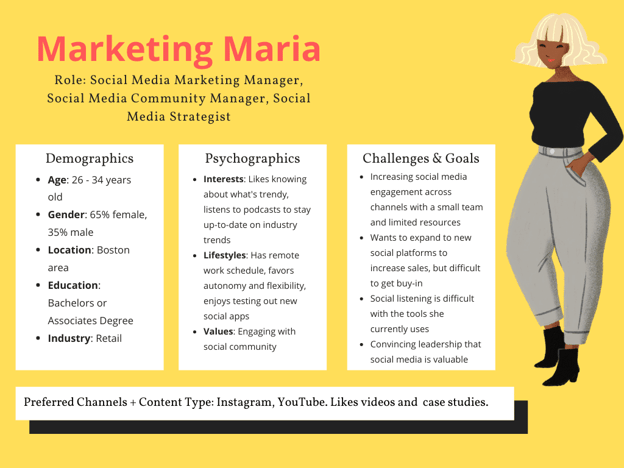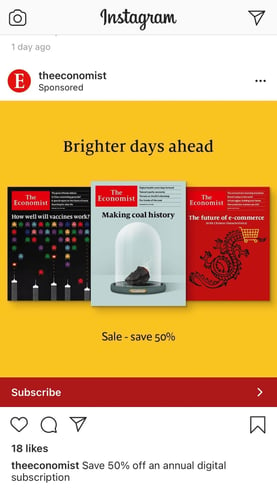Determining your audience profile is a critical step in ensuring your campaign is successful.
An audience profile can help you personalize your campaign’s messaging to reach those most likely to convert, and limit the amount of spend you might’ve otherwise wasted on underperforming ads.
Here, we’ll explore the information you need to include in an audience profile, how to write an audience profile, and audience profile examples.
Table of Contents
What is an audience profile?
What information should I include in an audience profile?
How to Write an Audience Profile
Why is audience profiling important?
Audience Profile Examples
Media Audience Profiles

What is an audience profile?
An audience profile details important information related to a fictional character you’ve decided to target for a specific marketing or advertising campaign. The audience profile is modeled after your business’ target audience, and is meant to help you create a more personalized, higher-converting campaign.
An audience profile is different than a target market, or buyer persona.
A target market includes every single prospective buyer for your product or service. For instance, perhaps you sell software that can be used for different use cases in different industries. In this case, a target market includes the prospects in each industry who could benefit from your product — all with different needs, goals, challenges, and beliefs.
An audience profile, on the other hand, is one fictitious person who you’re targeting with an upcoming campaign.
An audience profile also isn’t a buyer persona. A buyer persona is the final person who will ultimately purchase your product or service, but in many cases, you’ll want to market to anyone who can influence the final buyer.
For instance, your audience profile might be a social media manager, even though the buyer persona is a company’s CMO, since she’ll have final sign-off.
What information should I include in an audience profile?
When creating an audience profile, you’ll need to include the following:
- Demographic information: This includes personal attributes like geography, age, education, occupation, and income.
- Psychographic information: This includes attributes related to personality traits, interests, attitudes or beliefs, and lifestyle.
- Goals, challenges, or pain points: For this section, determine your audience’s goals, challenges, or pain points as it relates to your product or service. How can your product or service meet your audience’s needs? What search queries does your audience use to find your product or service? For instance, if you’re selling an 8-week mindfulness program, then your fictional character likely has a big challenge with focusing and finding time to ground himself in the present moment.
- Values: What does your target audience value? This includes bigger-picture values and motivators, such as “nature”, “socializing”, “a sense of belonging”, or “autonomy at work”.
- Preferred channels: What channel(s) does your audience spend the most time? This could be social channels, such as YouTube or Instagram, or search engines like Google. The preferred channel depends on the type of campaign you’re running. If you’re running a paid advertising campaign, for instance, you’ll want to determine if your audience spends most time on Facebook, Google, or somewhere else.
- Preferred content type(s): Once your audience finds your content, what format would they prefer it in? E-books, blog posts, or case studies? Or podcast? Video? Determining the format will help you best serve your audience.
- Buying behavior: Is your audience impulsive, or do they need weeks — if not months — before making a purchase? Are they open to your product or service anytime during the year, or only during a certain season? If you sell beach chairs, for instance, your target audience is likely relatively impulsive during the summer months, when a beach chair is most necessary.
Next, let’s dive into how you can write an audience profile.
How to Write an Audience Profile
1. Determine the goal(s) of your upcoming campaign.
Before writing your audience profile, you want to know who you’re targeting with your marketing campaign.
For instance, are you creating high-intent advertisements to target buyers with your products or services? Or, alternatively, are you hoping to increase attendees at an upcoming marketing event?
You’ll make a different audience profile depending on your goals. If you’re hoping to increase sales for your product via a social media advertising campaign, then your audience profile will look similar to your buyer persona.
If, instead, you’re hoping to increase views to your YouTube channel, then your audience profile will look like a fictional character based off your YouTube analytics to determine who enjoys watching your content.
2. Dive deep into analytics.
Once you’ve determined your campaign goal, use data and analytics to create a prototype of your persona.
Start with Google Analytics to explore demographic information related to your website visitors. Take note of age, gender, location, and types of device — additionally, figure out from which channels your audience arrives. Is it typically organic search, a social channel, email, or paid advertising?
You can also use CRM data to further explore what customers convert at the highest rate. For instance, you might use your CRM to determine which industries convert the most, or which pages have the highest conversion rate, to refine your audience profile depending on existing customers’ behavior.
Finally, use channel-specific metrics to fill in the missing pieces. If you’re planning on running a Google ads campaign, you might dive into past high-performing ads and who clicked on those ads.
Alternatively, if you’re running a Facebook campaign, you can use Facebook’s lookalike audience feature to reach people who are similar to your best existing customers.
3. Use qualitative metrics to determine your audience’s biggest challenges.
To fill out the challenges/goals/pain points section of your audience profile, it’s a good idea to take a look at customer reviews or focus group intel to determine the biggest challenges your prospects and customers face.
You can also use keyword research to find high-intent keywords related to your products or services, which might help you determine your audience’s biggest challenges, as well.
For instance, let’s say you’re creating a new advertising campaign related to a social media listening and scheduling tool.
You might first leverage Ahrefs or another keyword explorer tool to determine questions people ask related to a given search query. In this example, I searched “social media tools” to find similar questions related to the search keyword:

I also searched “social media tools” on Google and looked at the People Also Ask feature to dive deeper into questions, pain points, and challenges related to social media tools:

Combined with your qualitative, customer-focused research, you’ll be able to uncover the biggest challenges of your audience, and how you should tailor your campaign to target those pain points.
4. Collect psychographic data using Google Trends or influencers in the industry.
If you work for a B2C company, consider consuming content from top influencers in a given industry to determine psychographic data for your audience profile.
For instance, if you’re selling fitness gear, take a look at the social profiles and blog posts of top fitness influencers. What do they care about? What do they value? What activities do they do in a given day? These characteristics can help you round-out your audience profile.
If you’re working for a B2B company, you might read industry case studies, reports, or join webinars to determine the interests, values, and behaviors of your target persona within a given industry.
An example of this might be reading “2020 Trends in Sales Management” if you’re hoping to target sales managers at your target companies.
Why is audience profiling important?
There’s a big difference between knowing your audience and assuming you know your audience.
When you truly know your audience, you can create effective campaigns that speak to (or solve for) their challenges, goals, and pain points. Audience profiling can help you get there.
Through audience profiling, you can:
- Create more personalized campaigns. It’s no secret that consumers want (and expect) personalized experiences. With audience profiling, you can build personalized campaigns that deliver relevant content, offers, and recommendations to specific customer segments.
- Optimize your strategies. Your marketing strategies should evolve with your customers’ changing needs, preferences, and behaviors. Audience profiling ensures that you’re meeting the right audience at the right time through the right channels.
- Drive more loyalty. By building targeted and relevant campaigns, marketers can create meaningful experiences for their customers. When you do this consistently, your customers will trust that you can meet their expectations, resulting in greater brand loyalty.
- Gain a competitive advantage. By knowing your customers better than your competitors do, you can tailor your products, services, and marketing strategies to meet customer needs and stand out from the crowd.
Ready to get started creating your own audience profiles? Let’s take a look at two examples you can use for inspiration before you create your own.
Audience Profile Examples
1. B2B Audience Profile Example: Marketing Maria

2. B2C Audience Profile Example: Athletic Andy

Media Audience Profile
Media planning and buying can’t happen without an audience profile.
For instance, media buying — buying campaign or advertising space on various channels, or sharing targeted campaigns and ads — can’t happen without media planning.
And media planning, at its core, is “determining how, when, where, and why your business shares media content with your audience. The process includes deciding what media will be shared on what channels to boost reach, engagements, conversions, ROI, and more.”
Ultimately, then, both media planning and media buying need pre-defined audiences to be successful. If you haven’t taken the time to create an audience profile before purchasing ad space, you risk wasting money and resources on audiences who ultimately won’t convert anyway.
An audience profile can affect where you place your advertisements. Once you’ve created an audience profile, for instance, you might find your audience persona spends most of her time on LinkedIn. LinkedIn advertising solutions, then, can help you best reach your target audience.
An audience profile also influences the design of your ad. You’ll want to design ad copy around your audience’s interests, pain points, and preferences — something you can only do once you’ve created an audience profile.
For instance, The Economist might’ve created an audience profile and determined their audience likes education and knowledge, but doesn’t like getting bogged down with too much negativity, particularly from news outlets. As a result, a simple tagline, “Brighter days ahead”, helps attract and convert the right audience through their ads.

Ultimately, your audience profile is a vital foundation for ensuring you’re effectively attracting and converting those best-suited for your brand.
However, an audience profile can vary depending on each individual campaign — so feel free to keep this post bookmarked for the next time you need to alter your audience profile for a new advertising or marketing campaign.

Credit: Source link

![What is an Audience Profile? [Steps + Examples] What is an Audience Profile? [Steps + Examples]](https://blog.hubspot.com/hubfs/Audience%20Profile.png#keepProtocol)









